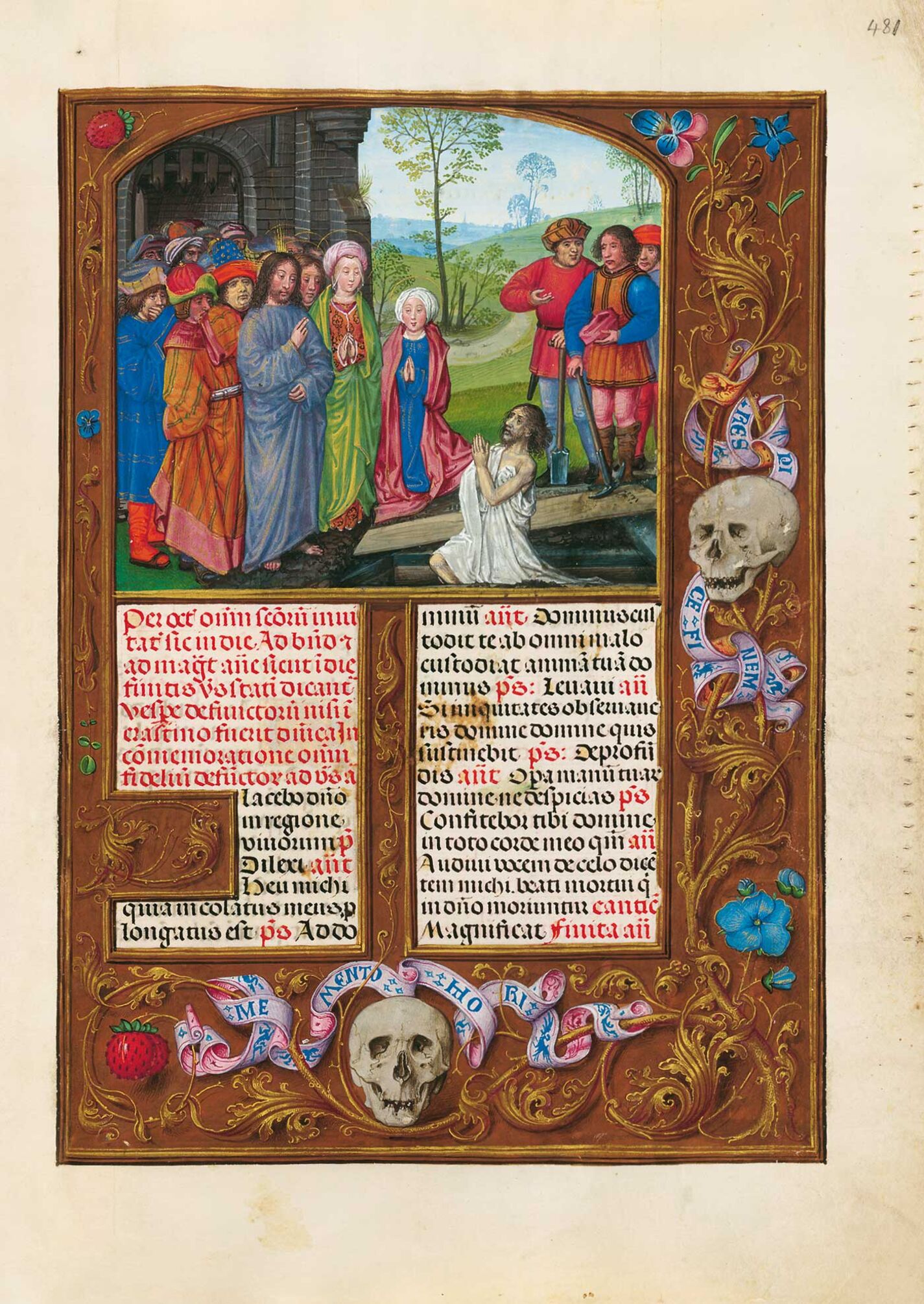Most of the paintings from 437r onwards in the
Isabella Breviary, i.e. about one third of those in the codex, are the work of Gérard Horenbout and his workshop. This painting illustrating the vespers of the dead depicts the resurrection of Lazarus. On the right, opposite the gate of a walled city, is a group of people led by Jesus making a blessing with his right hand in an eloquent gesture. He is accompanied on his left by Mary and Martha kneeling and, on his right, by a high-ranking person behind whom is a man covering his nose and mouth with his hand to avoid the smell of the tomb. The tombstone in this centre has been pushed aside and Lazarus arises half naked with the shroud covering part of his body. Finally, watching on the right are three men, two of whom can be identified as gravediggers by the spades they hold, and one commenting on the miracle. The landscape in the background, portrayed with exquisite moderation and feeling, features several trees and hills tinged with blue by the distance. The painting and text are surrounded by a border of acanthus painted in gold cameo with a variety of flowers and fruit sprouting from them in colours matching those of the main miniature, around two skulls. The one in the middle at the bottom is beneath a phylactery reading
memento mori, and written in the one on the right are the words
respice finem.
In early Christian times, the resurrection of Lazarus was interpreted as a prefiguration of the Resurrection of Christ and resurrection of the dead at the Final Judgement. For the first Christians it was the embodiment of their hopes of resurrection and eternal life. This is why it is depicted so often in third- and fourth-century catacombs and sarcophagi.
The oldest type of composition shows Christ, Lazarus and one or both of his two sisters and an apostle. The earliest examples of this miracle are found on early-Christian, glass bowls and the frescoes dated around 240-250 in the chapels in the San Calixto catacombs, Rome. However, a model featuring many figures was developed in Syrian-Palestinian art and conserved in the
Codex Pupureus Rossanensis (Rossano, library of the
Museo dell'Arcivescovado) dated in the third quarter of the 6th century. The group of Jews and apostles accompanying Christ to see the miracle varied in number. Since the 6th century, there has always been a figure covering its nose or mouth with one hand. A new model established in the 11th century was to provide the essential elements for the image in the Gothic period: the opening of the tomb and the efforts of the resuscitated man to rise up from the tomb by himself have iconographic parallels in the resurrection of the dead in the image of the Final Judgement. Lazarus lies in a stone tomb and, unlike in earlier works, the upper part of his body, wrapped in a shroud, is slightly raised. In the bronze reliefs on the Hildesheim column, a nude Lazarus is depicted coming back to life, rising up from the tomb, looking at Christ and answering his call with the gesture of his hands in prayer. In the latter half of the 15th century, Flemish painters began to use this theme again. It became commonplace to depict not only the sarcophagus that the resuscitated man sits on, but also a grave, with Lazarus sitting either in the opening or on the tombstone.